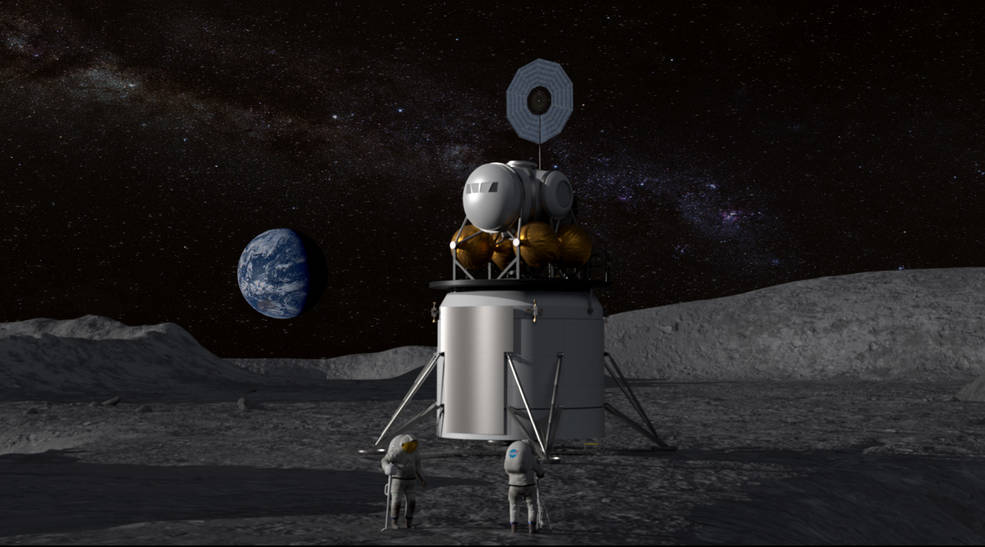
NASA is counting on private industry to help advance the exploration frontier.
The agency is partnering with more than a dozen U.S. companies, including SpaceX and Blue Origin, on 19 different technology-development projects, NASA officials announced Tuesday (July 30).
The companies will work with various NASA centers, which will provide their facilities, expertise, hardware and software at no charge under Space Act Agreements. The main goals of the partnerships involve further spurring the commercial space sector and helping to mature technologies that could benefit NASA and the nation down the road — for example, by assisting the agency's drive to land astronauts near the moon's south pole by 2024.
Related: Moon Rush: These Companies Have Big Plans for Lunar Exploration
"NASA's proven experience and unique facilities are helping commercial companies mature their technologies at a competitive pace," Jim Reuter, associate administrator of NASA's Space Technology Mission Directorate (STMD), said in a statement. "We've identified technology areas NASA needs for future missions, and these public-private partnerships will accelerate their development so we can implement them faster."
The selected companies range from small businesses with just a handful of employees to aerospace heavyweights such as Lockheed Martin, Blue Origin and SpaceX.
Indeed, Blue Origin, which is run by Amazon.com founder Jeff Bezos, snared three of the newly announced partnerships. The company will work with NASA's Langley Research Center in Virginia and Marshall Space Flight Center in Alabama to develop and evaluate materials for possible use on lunar landers' rocket-engine nozzles.
Get the Space.com Newsletter
Breaking space news, the latest updates on rocket launches, skywatching events and more!
Blue Origin will also partner with Johnson Space Center in Houston and Goddard Space Flight Center in Maryland on two separate projects, NASA officials said. One project will develop a navigation and guidance system for precise moon landings, and the other aims to mature a fuel-cell power system for the company's Blue Moon lander.
Two of the 19 partnerships involve SpaceX. Elon Musk's company will work with the Marshall center and Glenn Research Center in Cleveland on ways to transfer propellant in orbit, tech that could aid the development of SpaceX's Mars-colonizing Starship vehicle, NASA officials said.
SpaceX will also work with NASA's Kennedy Space Center in Florida on how best to land Starship on the moon. This project will include modeling work that will assess the interaction of engine plumes with lunar regolith, NASA officials said.
"We believe SpaceX's fleet of advanced rockets and spacecraft, including Falcon Heavy and Starship, are integral to accelerating NASA's lunar and Mars plans," a SpaceX spokesperson told Space.com via email.
The other selected companies are Advanced Space of Boulder, Colorado; Vulcan Wireless of Carlsbad, California; Aerogel Technologies of Boston; Spirit AeroSystems Inc. of Wichita, Kansas; Anasphere of Belgrade, Montana; Bally Ribbon Mills of Bally, Pennsylvania; Sierra Nevada Corp. of Sparks, Nevada; Maxar Technologies of Palo Alto, California; Aerojet Rocketdyne of Canoga Park, California; and Colorado Power Electronics Inc. of Fort Collins, Colorado. (SpaceX is based in Hawthorne, California, and Blue Origin calls Kent, Washington, home. Lockheed Martin's headquarters are in Colorado.)
You can read more about all 19 projects here.
NASA's 2024 crewed moon push is part of the agency's Artemis program, which aims to establish a long-term, sustainable human presence on and around the moon over the next decade or so. If all goes according to plan, such work will inform humanity's next giant leap: a crewed mission to Mars, which NASA aims to pull off in the 2030s.
The space agency plans to make all this happen with the help of private industry and international partners. For example, the science and technology-demonstration missions to the lunar surface that will help pave the way for the 2024 crewed mission will ride aboard privately built landers.
- NASA's Full Plate of Moon Missions Before Astronauts Can Go
- Moon Master: An Easy Quiz for Lunatics
- Apollo 11 at 50: A Complete Guide to the Historic Moon Landing Mission
Editor's note: This story was updated at 12:20 p.m. EDT on July 31 with a quote from a SpaceX spokesperson.
Mike Wall's book about the search for alien life, "Out There" (Grand Central Publishing, 2018; illustrated by Karl Tate), is out now. Follow him on Twitter @michaeldwall. Follow us on Twitter @Spacedotcom or Facebook.
Join our Space Forums to keep talking space on the latest missions, night sky and more! And if you have a news tip, correction or comment, let us know at: community@space.com.

Michael Wall is a Senior Space Writer with Space.com and joined the team in 2010. He primarily covers exoplanets, spaceflight and military space, but has been known to dabble in the space art beat. His book about the search for alien life, "Out There," was published on Nov. 13, 2018. Before becoming a science writer, Michael worked as a herpetologist and wildlife biologist. He has a Ph.D. in evolutionary biology from the University of Sydney, Australia, a bachelor's degree from the University of Arizona, and a graduate certificate in science writing from the University of California, Santa Cruz. To find out what his latest project is, you can follow Michael on Twitter.









